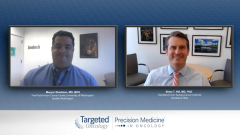
CD19-Targeted mAbs in RR DLBCL Using Loncastuximab Tesirine
The doctors switch their monoclonal antibody conversation’s focus to longcastuximab tesirine for the treatment of relapsed/refractory diffuse large B-cell lymphoma.
Episodes in this series

Mazyar Shadman, MD, MPH: Now, CD19, here we targeted with a naked antibody, the CD19 antibody. We can also attach the chemotherapy agent to it, and that would be an antibody-drug conjugate.Loncastuximab tesirine, or Lonca, is an antibody-drug conjugate targeting CD19. It is now approved as monotherapy for large cell lymphoma. It’s a recently approved drug, and experience is less compared to tafasitamab and CAR [chimeric antigen receptor] T-cell therapy. Where do you see that sitting in your treatment landscape?
Brian T. Hill, MD, PhD: It’s been quite a couple of years here. We had nothing for patients in terms of FDA-approved agents until we had CAR T, and now we have 3 drugs at least for relapsed/refractory diffuse large B-cell lymphoma. Loncastuximab tesirine is an antibody-drug conjugate that targets CD19. The agent that it’s conjugated to is an alkylator, so it has the ability to deliver high concentrations of an alkylating agent intracellularly into the B-cell target. As a result, it only needs to be given once every 3 weeks, and it’s given as a single agent. In the LOTIS-2 trial, which is again a single-arm phase 2 study, there were about 145 patients, and the overall response rate was 48%. There’s a high likelihood of response for relapsed/refractory diffuse large B-cell compared to historical single-agent drugs where the response rate is often in the 20% to 30% range.
As a single agent, the toxicities primarily are myelosuppression, you do have some patients get rash and GI [gastrointestinal] toxicities, of course, but overall, it seems to be a very active medication. We don’t have as much follow-up, but of the people who have complete remissions or even just PRs [partial responses], you see pretty good durability. It’s hard to make comparisons with the patient population in the L-MINE trial and say, well, if we want to pick a PFS [progression-free survival] point and compare, I would be hesitant to do that. What we can say now is that we do have a very active single agent here with loncastuximab for this patient population.
One of the things that’s starting to come up and will also be even more important if we begin using polatuzumab in the front line, is that at the time of relapse, your only options may be chemotherapy with or without anti–CD19-targeted antibody or antibody-drug conjugates in terms of novel agents.I’m curious to know your perspective on giving anti–CD19-targeted therapies in patients who you’re trying to get to CAR T-cell therapy, which as we know targets CD19 as well.
Mazyar Shadman, MD, MPH: That’s a natural concern. It’s the same story with CD20 therapies that use bispecific antibodies, for example, and most of the patients are previously exposed to CD20-targeting drugs like rituximab. What is promising is that there are now a few publications with Lonca at least, showing that patients who came off Lonca, the CD19 expression was not affected significantly—one paper came from the same study group, and I’ve seen recent ones even in the Lonca data that they presented, some of the patients basically stopped treatment and moved on to CAR T therapy, and there were responses there, too.
The duration of exposure is important. When I think about Lonca, probably it’s something that if I use it before CAR T, I’d use it as a bridge to CAR T. In fact, I think you will see a higher rate of using it pre-CAR T. If POLA [polatuzumab] moves to the first-line setting and patients come with relapse after first line, the most commonly used drug for bridging purposes these days is POLA [polatuzumab] for us, and probably we’ll be doing more Lonca. With the number of doses that we’ll be giving, it most likely won’t be a problem, but who knows? With long exposures to a drug like TAFA [tafasitamab], we’re going to be thinking about that. That’s an active question in the field as we know.
In my practice these days, if I have somebody coming off a CD19-targeted antibody for CAR T, if they have a lymph node that could be easily biopsied, I tend to look at CD19 if possible. We don’t want to put a patient through the whole 2 months of staying here and going through the CAR T therapy if they don’t have any CD19 attrition. We have to be very careful that, having no CD19 is one thing, but I would still want to use CAR T even if the expression is at a low level. We really don’t know what that means clinically. In the ZUMA-1 study, they looked at CD19 expression by IHC [immunohistochemistry], and at least in that report, the patients who were negative by that test still responded, and we do see the same clinical responses with CD20 negativity.
To summarize, yes, it is a concern it sounds like right now based on the reports, clinical reports from Lonca and some mainly preclinical reports, and I saw a case report for TAFA [tafasitamab] that patients were still treated with CD19-targeted CARs and responded after these drugs. But we need more data, and duration of previous exposure is important. That’s something that we have to make clinical decisions about as we move forward.
Brian T. Hill, MD, PhD: Yes, I agree. I see loncastuximab fitting in the treatment paradigm as either a bridge to CAR T, but of course you’re still going to have patients after CAR T-cell treatment who aren’t in remission, and CD19 loss is known at that time, but has only been documented in about 20% to 30% of cases at most. Most of the relapses after CAR T are probably from a different mechanism rather than CD19 loss. In those settings, loncastuximab does make sense.
This transcript has been edited for clarity.








































